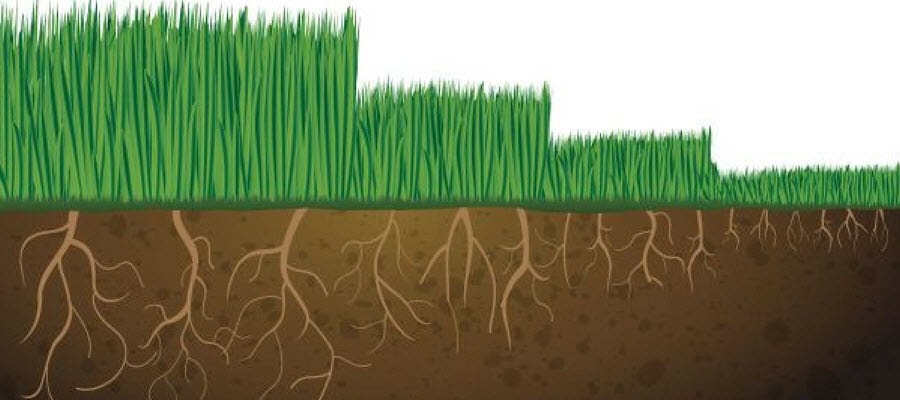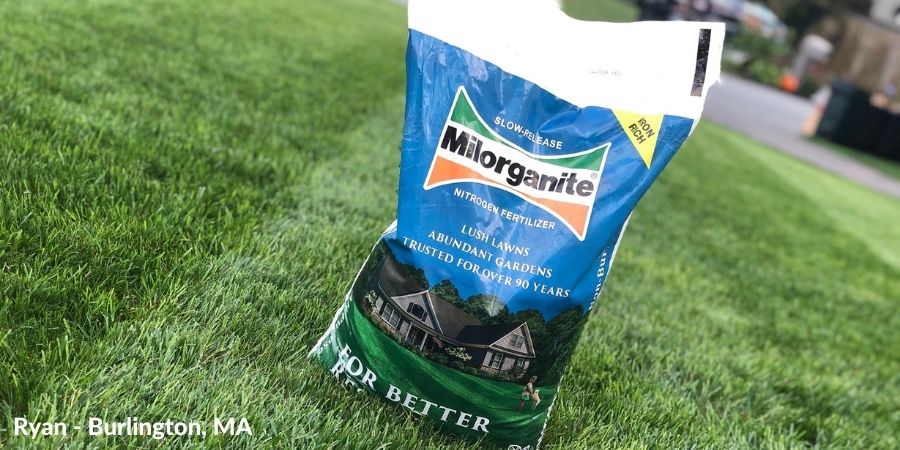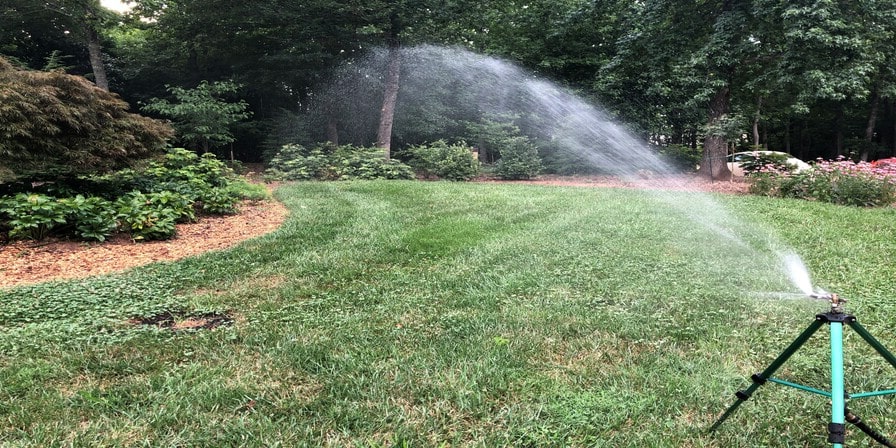5 Steps to a Healthy Lawn
- horticulturist and gardening expertSeptember 10, 2022
Grass provides a green backdrop for gardens, living walkways and play space for children. Healthy lawns also help prevent erosion, have a cooling effect in summer, improve flood control and keep our feet from getting muddy when it rains. You can make lawn grass part of your landscape and be kind to the environment, too. It’s just a matter of changing or fine-tuning your lawn care practices.
Let’s start with a quick review of lawn care basics. Proper mowing, watering and fertilization can be the difference between a healthy lawn and a weed patch. The amount of effort you put into your lawn depends on the quality of grass you desire and the amount of use the lawn receives. Following these five steps can help you grow and maintain the lawn you want:
1) Mowing Height and Frequency
Deciding how short to mow your lawn depends on the type of grass you are growing. Cutting the grass short does not mean you mow less often. It just stresses the grass, reduces the lawn density and allows weeds to dominate. Rain fall and temperature influences how fast grass grows and how often you’ll need to mow your lawn. So let your lawn not the calendar be your guide.

- Start by checking the current height you are mowing your grass. Most people need to raise the mowing height. Grow cool season grasses like bluegrass, fescue, and ryegrass 2-1/2 to 4 inches tall. Mow warm-season grasses like Bermuda grass, carpetgrass, centipedegrass and zoysia to 1 to 2 inches tall while St. Augustine should be a bit higher, 2 to 3 inches, for best results.
- Taller grass shades out some weeds and forms deeper roots, making it better able to compete with weeds and more tolerant of drought, insects and diseases.
- Make sure your mower blades are sharp for healthier and better-looking grass. The clean cut made by a sharp blade will close more quickly so the grass loses up to 30% less water. You’ll also be able to mow more efficiently and will use up to 22% less fuel.
- Remove no more than 1/3 the total height of the grass at one time to reach the desired grass height. This removes just enough to keep your lawn healthy and not too much to stunt the lawn. Regularly removing too much grass at a time increases weed invasions, diseases and results in a thin stand of grass.
- Leave clippings on the lawn. Short clippings DO NOT cause thatch and break down quickly, adding moisture, organic matter, and nutrients to the soil. A season’s worth of clippings is equal to one fertilizer application.
- Mow over long clippings to cut them down to size when needed. Long clippings can contribute to thatch so the extra pass of the mower is worth the effort.
- Always sweep clippings off walks and the drive and back onto the lawn. This reduces the risk of them washing into nearby storm sewers and waterways contributing to water pollution. Placing clippings back on the lawn puts this valuable resource where it belongs.
2) Lawn Fertilizer Tips
- Knowing how much fertilizer for the lawn should be based on the quality of the lawn you desire, time you are willing to spend managing your lawn and how much foot traffic your lawn receives. High-quality heavily used lawns need the maximum amount of fertilizer and maintenance, while low maintenance, low-use lawns need the least. Providing sufficient fertilizer promotes dense healthy lawns better able to outcompete weeds and resist insect and disease problems.
- Start with a soil test so you know how much and what type of fertilizer your lawn needs. Contact your local extension service for details on where to send soil samples for testing.

- Fertilize cool-season grass lawns in the North and Midwest around Memorial Day, Lab,or Day and mid-November to Thanksgiving before the ground freezes. The last application is known as dormant fertilization which promotes a healthier greener spring lawn. Fertilize Memorial and Labor Day only for low-maintenance lawns and add a light summer feeding if you are watering and growing a high-quality lawn. Only fertilize lawns in Michigan, Maryland, and Pennsylvania twice a year per state regulations.
- Fertilize low-maintenance warm-season grass lawns around Easter when the lawn breaks dormancy and begins to grow and again Memorial Day for low-maintenance lawns. Add a few more applications, one around Labor Day and early October when growing a high-maintenance lawn. Your last application should be at least 6 weeks before the first fall frost. Fertilize Florida and Maryland lawns no more than twice a year per state regulations.
- Always check local ordinances for any fertilization blackout dates and restrictions.
- Increase success and decrease the risk of damage by using Milorganite fertilizer. It’s a low nitrogen slow-release fertilizer that won't burn the lawn even when the weather turns hot and dry. The iron promotes green growth and the phosphorus is non-leaching. Plus when the microorganisms release the nutrients from the Milorganite pellets some of the phosphorus and potassium bound to the soil, is made available to the grass plants.
- Never apply fertilizer to frozen soil and always sweep any fertilizer off walks, drive and other hard surfaces and back onto the lawn. Both practice reduce the risk of fertilizer washing into nearby storm sewers and waterways contributing to water pollution.
3) Lawn Watering Tips
Knowing how much water a lawn needs can be challenging. Just like fertilizing it depends on the quality of lawn you desire and the amount of water you are willing and able to apply. Proper watering is key to a healthy lawn and water use. Recent droughts, efforts to conserve, and watering restrictions may require a change of habit. These lawn watering tips should help you develop a watering strategy that is best for your situation.
- You may decide or be required to allow your lawn to go dormant during drought.
- Protect the dormant grass by minimizing foot traffic and play on dormant lawns.
- Don’t apply herbicides or quick-release fertilizer to dormant lawns. The fertilizer will feed the weeds and both can damage the dormant grass.
- Once you let your lawn go dormant, leave it dormant until the weather improves and rains return. Lightly water dormant grass during extended dry periods. Apply ½ inch of water every 2 to 3 weeks to keep the grass alive while remaining dormant.
- If you choose to water the lawn throughout the growing season, doing so properly is key to promoting dense healthy growth.
- Apply enough water to moisten the top 4 to 6 inches of soil. This encourages deeply rooted drought and pest-tolerant grass.
- Only water when needed. Your footprints will remain in the lawn when the grass needs watering.
- Water early in the morning if possible. Less water will be lost to evaporation and you reduce the risk of disease by avoiding wet grass blades overnight.
- Use Milorganite as your lawn fertilizer. It promotes balanced more drought tolerant growth and won’t burn even during a drought. Milorganite remains in the soil until the weather improves and the grass begins to grow.
4) Manage Lawn Weeds
A healthy lawn is your best defense against and way to help get rid of weeds in the lawn. When weeds occur it usually means the growing conditions are better for the weeds than the grass. Adjust your lawn care practices (steps one through 3) to improve the health and density of the lawn so it can crowd out the weeds.
- Core aerate lawns growing on compacted soil or those with half an inch of thatch or more. This practice creates openings in the soil allowing water and nutrients to reach the grass roots. Covering the lawn with compost, topdressing, after aeration further improves the soil. Some of the compost fills the holes improving the soil where the grass roots grow. The compost on the soil surface helps break down the thatch.
- Hand dig small populations of weeds removing the roots and all. The traditional dandelion digger is still effective but a few weeding tools allow you to remove weeds from a standing position.
- If you decide to use chemicals to kill lawn weeds, just spot treat problem areas instead of applying them to the whole lawn. You will use fewer chemicals saving you money and adding less to the environment.
- Consider using organic weed killers to minimize the impact on the environment.
- Always read and follow label directions whether using organic, natural or synthetic weed killers. These products are designed to kill plants and can harm desirable plants and have a negative impact on the environment if misapplied.
5) Eco-Friendly Lawn Care
Maintain the benefits and beauty your lawn provides while being kind to the environment. Start by adjusting routine care as needed to minimize impact on the environment. And as you make these changes you may decide to take the next step and adopt organic lawn care.
- Improve the soil to increase the health and vigor of your lawn. Proper fertilization, core aerating if needed and topdressing with compost helps improve the existing soil and grass growth without replacing your lawn.
- Always sweep grass clippings and fertilizer residue off the walks and drives. This simple step keeps unwanted nutrients out of our waterways and eventually drinking water.
- Never fertilize lawns when the ground is frozen. When snow melts or rain falls on frozen lawns the fertilizer is washed off the lawn and into nearby storm sweres.
- Use Milorganite fertilizer. It contains 85% organic matter feeding the soil as well as the lawn. It has been sustainable for over 90 years recycling nutrient-rich microbes into fertilizer. Milorganite's production plant uses methane from nearby landfills as a fuel source.
- Sharpen or change mower blades at least twice a season. This simple act can help reduce water use by up to 30% and fuel used by up to 22%.
- Consider using a push or electric mower. It’s good for the waistline and the environment.

